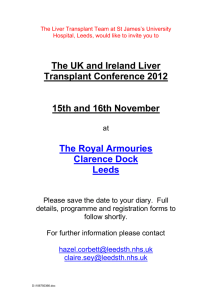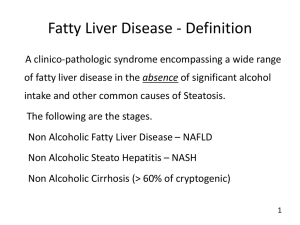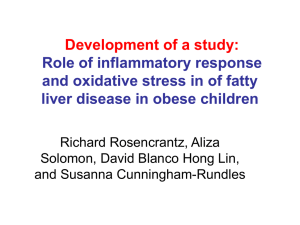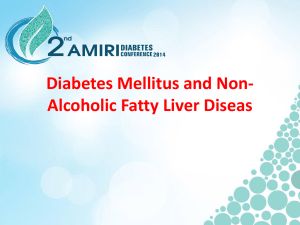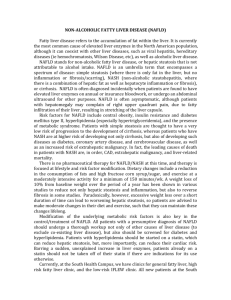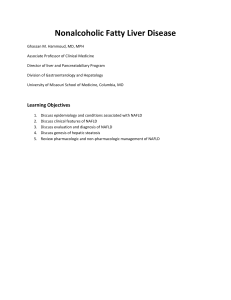Fatty Liver Disease - Vanderbilt University Medical Center
advertisement
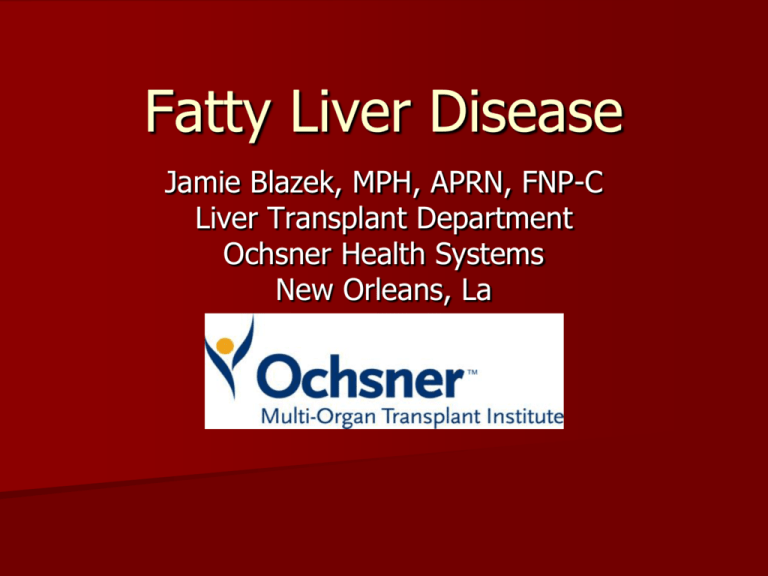
Fatty Liver Disease Jamie Blazek, MPH, APRN, FNP-C Liver Transplant Department Ochsner Health Systems New Orleans, La Disclosures None Objectives Identify risk factors for fatty liver disease Order appropriate screening tests Diagnose and treat fatty liver disease Initiate appropriate referrals Terminology ALD: Alcoholic Liver Disease Significant alcohol consumption* > 21 drinks/week for males > 14 drinks/weeks for females NAFLD: NASH: Non-Alcoholic Fatty Liver Disease steatosis without hepatocyte injury Non-Alcoholic Steatohepatitis steatosis with inflammation, hepatocyte injury with or without fibrosis *Sanyal, et al Hepatology 2011 Fatty liver Normal liver Statistics Alcoholic liver disease – 15 million people abuse/overuse ETOH in USA – 90% of those will develop fatty livers – Moderate use with another risk factor Non-alcoholic liver disease – Most common chronic liver disease in USA – 4th most common reason for liver transplant Projected to be the most common in 10-20yrs – Up to 20-40% adults – 6 million children By 2020 Natural History of FLD fatty liver steatohepatitis steatohepatitis + fibrosis steatohepatitis + cirrhosis cryptogenic cirrhosis Mortality risk: Cirrhotics with NAFLD vs hepatitis C Sanyal,et al Hepatology 2006: – NAFLD had lower rate of mortality Yatsuji, et al Gastroenterology and Hepatology 2009: – No difference Both showed pts with NAFLD at lower risk for HCC than Hepatitis C pts. NAFLD: risk factors Middle age Female gender Over-weight or obese Viral hepatitis Iron overload Medications Rapid weight loss Starvation/refeeding syndrome Reye’s syndrome Auto-immune disease Malnutrition Abetalipoproteinemia Overgrowth of bacteria in small intestines TPN Acute fatty liver of pregnancy HELLP syndrome Hispanic ethnicity Hereditary Risk factors: Established association Obesity Type 2 DM: insulin resistance (IR) Dyslipidemia Metabolic syndrome (MS) Risk factors: Emerging association Polycystic ovary syndrome Hypothyroidism Obstructive sleep apnea Hypopituitarism Hypogonadism Pancreatic-duodenal resection Risk factor: Medications Amiodarone Methotrexate Tamoxifen Corticosteroids Diltiazem Valproic acid Highly active antiretroviral therapy Risk factor: Bacteria overgrowth Grieco, et al. Hepatology 2009 – – – – 35 pts with NAFLD bx confirmed 27 pts with celiac disease 24 healthy individuals Those with FLD had increased intestinal permeability and increased small bowel bacterial overgrowth Compare, et al Nutrition Metabolism & Cardiovascular Disease Feb 2012 – Liver is 1st line of defense against gut-derived antigens – Levels of bacterial lipopolysaccharide (component of GN bacteria) are increased in the circulation in several types of chronic liver disease – Can modulation of gut microbia represent a new way to treat/prevent NAFLD???? Screening Considerations AASLD rec’s Liver biochemistries can be normal Ultrasounds are expensive General population screening not recommended Undergoing surgical procedure? Planned pregnancy with obese mother? Systematic screening of family members: not recommended at this time Further work-up indicated Incidental finding on imaging for some other reason Abnormal liver enzymes Symptoms of liver disease Rule out other causes: alcohol, medications, hepatitis, etc. NAFLD fibrosis score Age BMI Hyperglycemia Platelet count Albumin AST ALT http://nafldscore.com NAFLD fibrosis score < -1.455: predictor of absence of significant fibrosis (F0-F2 fibrosis) ≤ -1.455 to ≤ 0.675: indeterminate score > 0.675: predictor of presence of significant fibrosis (F3-F4 fibrosis) Algorithm for evaluating NAFLD* *taken from AGA position paper 2002 Accidental discovery Screen those with risk factors AST or Symptomatic liver disease AST elevated normal r/o other causes of liver disease monitor ongoing alcohol yes Abstain no Imaging study Echogenic US or fat on CT May need biopsy Liver biopsy AASLD rec’s Incidental finding on imagery with normal enzymes: no biopsy indicated, monitor. Presence of metabolic syndrome and persistently elevated biochemistries may benefit from liver biopsy Patients with biopsy proven NASH cirrhosis should be screened routinely for esophageal varices and HCC Assessment Symptoms – Malaise, fatigue, RUQ discomfort – Snores, disturbed sleep, wakes up tired – Chronic pain disorders, achy muscles Physical exam – Abdominal obesity – Enlarged liver – RUQ tenderness on palpation Labs – Consistent with metabolic syndrome – Elevated bilirubin, AST, ALT, AP, GGT Management: Lifestyle Interventions Lifestyle Interventions Weight loss by lower caloric intake and increased physical exercise * led to improvement in biopsy. 9.3% weight loss: improvement in steatosis, necrosis, and inflammation; not fibrosis 3-5% weight loss improves steatosis but more is needed to improve inflammation Alcohol consumption: – heavy intake should be avoided – light intake (<1/day) may have benefits**, may not*** * Promrat, et al. Hepatology 2010 ** Dunn, et al. Hepatology 2008 ** Gunji. et al. Am J Gastro 2009 ** Moriya, et al. Alim Pharm Ther 2011 ***Ruhl , et al. Clin Gastro Hepatol 2005 Management Medications Insulin sensitizing agents Metformin * – reduction in IR and enzymes, – no improvement in histology Thiazolidinediones – Rosiglitazone**: improved enzymes and steatosis, but not inflammation – Pioglitazone:***+weight gain, but improvement in hepatocellular injury *Uygun, et al Aliment Pharm Ther 2004 *Nair, et al Aliment Pharm Ther 2004 **Ratziu, et al Gastroenterology 2008 ***Sanyal, et al NE J Med 2010 PIVENS Study Pioglitazone , Vitamin E, placebo 96 weeks Adults – with NASH – without DM, cirrhosis, Hep C, heart failure – limited alcohol intake over previous 5 years Randomized trial – Pio group: 80 – Vit E group: 84 – Placebo: 83 Sanyal et al, New England J of Medicine 2010 Primary outcome Vitamin E vs placebo 43% improvement vs 19%: significant (Steatosis, lobular inflammation, hepatocellular ballooning and fibrosis) Pio vs placebo 34% improvement vs 19%: not significant Sanyal et al, New England J of Medicine 2010 Secondary outcome Vitamin E vs placebo – Also reduction in SGOT/SGPT Pio vs placebo – Reduction in SGOT/SGPT – Reduction in steatosis, lobular inflammation – Improvement in IR – Increase in weight that did not resolve after discontinuance of Pio Sanyal et al, New EngJ of Med 2010 PIVEN Conclusions Vitamin E was superior to placebo in adults with NASH and without DM Pioglitazone may have a role in treating patients with biopsy-proven NASH, however long term safety and efficacy has not been established Sanyal et al, New EnglJ of Med 2010 AASLD recommendations: Pio can be used to treat certain patients with biopsy-proven NASH who do not have DM but long term safety and efficacy has not been established Vitamin E 800 IU/day improves liver histology in NASH pts – Not recommended to treat NASH in those with other chronic liver diseases, diabetics, those with NASH cirrhosis or cryptogenic cirrhosis, NAFLD without biopsy Vitamin E: other concerns Meta-analysis* including 136,000 participants found taking Vitamin E supplements > 400 IU/day had a higher risk of all cause mortality Vitamin E** > 400 IU/day increases risk of prostate cancer in relatively healthy men *Miller et al Annals of Internal Medicine 2005 ** Klein, et al, JAMA 2011 Other meds for NASH Ursodeoxycholic acid* – no histologic benefit Omega-3 fatty acids** – Effective in treating hypertriglyceridemia in pts with NAFLD – Evidence for treatment of NASH inconclusive to date – Large multi-center trial on-going now *Lindor, et al. Hepatology 2004 **Capanni, et al. Alimen Pharm Ther 2006 Statins CVD common cause of death for NAFLD and NASH Stratify risks and treat accordingly Several studies show NAFLD and NASH pts are not at increased risk of liver injury over general population* No RCTs with histological end points using statins to treat NASH *Chalasani, et al. Am J Gastro 2012 GREACE study* Concluded statins significantly improve liver biochemistries and CV outcomes in pts with elevated enzymes likely due to NASH Athyros et al Lancet 2010 AASLD Recommendation on Statins “Given lack of evidence that patients with NAFLD and NASH are at increased risk for serious drug-induced liver injury from statins, they can be used to treat dyslipidemia in patients with NAFLD and NASH.” Bariatric surgery No RCTs Cochrane review 2010: lack of RCTs prevents definitive assessment of risks/benefits Prospective study* – 381 adults with severe obesity, fibrosis score<3 – Clinical, metabolic, liver biopsy comparisons at 1 year and 5 years – Significant improvement in steatosis, ballooning, resolution of probable/definite NASH at 1 and 5 years – Small but significant increase of fibrosis score at 5 years (96% had improvement) *Mathurin et al Gastroenterology 2009 AASLD Recommendation on Bariatric Surgery Premature to consider foregut surgery as an option to specifically treat NASH Foregut surgery is not contra-indicated in otherwise eligible pts with NASH or NAFLD WITHOUT cirrhosis For those with cirrhosis: type, safety and efficacy of foregut surgery is not established Transplant Considerations MS & Immunosuppression Steroids – BP – lipid metabolism – gluconeogenesis induce IR weight gain peripheral glucose utilization CNIs : pancreatic beta cell toxicity – Nephrotoxicity – TAC - glucose intolerance and de novo DM – CSA - HTN and hyperlipdemia mTOR inhibitors – hyperlipidemia Metabolic Syndrome in Kidney Transplant* Metabolic syndrome (MS) may play a role in allograft loss and poor function Pathophysiology of MS is altered by immunosuppression * Hricik, Clin J of ASN 2011 Metabolic Syndrome in Kidney Transplant Prevalence of MS post KTx – 22.6% at 1 year* – 37.7% at 18 months* – 63% at a median of 6 years** * Porrini et al, Amer J of Kid Dis 2006 ** de Vries et al, Amer J of Trans 2004 Metabolic Syndrome in Kidney Transplant MS lowered creatinine clearance by 5mL/min after 7 years Systolic BP and hypertriglyceridemia had most negative impact *de Vries et al, Amer J of Trans 2004 Metabolic Syndrome in Kidney Transplant: Blood Pressure Choice of antihypertensive post KTx: Cochrane Group Review http://summaries.cochrane.org/CD003598/ blood-pressure-medication-for-kidneytransplant-recipients Metabolic Syndrome in Kidney Transplant: Hyperlipdemia ALERT trial* – Randomized, double blind, placebo control (N=1100) – Fluvastatin was superior to placebo in significantly lowering total and LDL cholesterol in renal transplant pts and in lowering rates of cardiac death and MI Hypertriglyceridemia: anecdotal use of fenofibric acid, fish oils, ezetimibe *Fellstrom et al Kid Internat 2004 Risk factors for NASH after liver transplant* Post transplant obesity TAC based regimen DM Hyperglycemia HTN ETOH as primary cause for transplant Pre-transplant allograft biopsy showing steatosis *Dumortier, et al Am J of Gastro March 2010 MS Post Liver Transplant 44-58% of pts > 6months post OLT BMI increase of 10% increases risk of post OLT NAFLD Associated with increased cardiovascular and cerebrovascular events CVD causes 19-42% non-liver related deaths Diabetes, HTN, IR add 2-fold increased mortality risk Watt & Charlton J Hepatology 2010 MS Post Liver Transplant Obesity – Between 1990 and 2002 the % of obese OLT recipients increased from 15% to 25% and average increase of 1kg/year* – Orlistat (tetrahydrolipstatin)** Limited efficacy May interfere with drug absorption – Post transplant bariatric surgery: few reported cases*** May interfere with drug absorption * Everhart et al, Liver Transpl Surg 1998 * Richards et al, Transpl Int 2005 ** Cassiman et al, Transpl Int 2006 ***Takata et al, Surg Obes Relat Dis 2008 *** Butte et al, Obes Surg 2007 *** Campsen et al, Obes Surg 2008 MS Post Liver Transplant* Diabetes post OLT – 5 year occurrence of advanced fibrosis is increased in patients treated for DM (49%) when compared to those with normal insulin sensitivity (20%) – Treatment goals same as general population * Watt & Charlton J Hepatology 2010 MS Post Liver Transplant* Dyslipidemia post OLT: 45-69% – Changing immunosuppression: CsA to TAC, Rapa to TAC, steroid free – High cholesterol: Statins: pravastatin most studied; does not require P450 enzyme system With other statins: reduction in TAC/CsA dose??? Mediterranean diet – High Triglycerides: fish oils Fenofibric acids derivatives: reduction in TAC/CsA dose??? ezetimide * Watt & Charlton J Hepatology 2010 MS and Heart Transplant* 48% of heart transplant recipients Long term survival better without MS Differences observed in MS group – – – – – Median age older Pre-tx creatinine higher Pre-tx HTN higher BMI higher Dyslipidemia higher rate No difference MS vs nonMS – – – – – Gender Underlying etiology Smoking DM history pre-tx Immunosuppression *Sanchez-Lazaro et al Transplantation Proc 2011 MS and Lung Transplant Impact of FLD on Donors Deaths due to CVA and CVD result in atherosclerotic vessels – Poorer quality organs – Fewer organs Discarded livers with>30% steatosis Special Considerations NASH and Hepatocellular Carcinoma Retrospective study* 6,508 pts with NAFLD by US F/up 5.6 years Primary end point: onset of HCC 16 new cases of HCC (0.25%) Cumulative rates of NAFLD-related HCC: – 0.02% at year 4 – 0.19% at year 8 – 0.51% at year 12 *Kawamura et al, Am J Gastroenterology 2011 Acute Fatty Liver & Pregnancy Presents at 35-36 weeks Mitochondrial dysfunction preventing oxidation of FFA which accumulate in liver Presents with malaise, N/V in 3rd trimester, RUQ pain, UGI bleed, ARF, FHF, confusion, HTN, jaundice, hypoglycemia Mortality: maternal 12.5-18%, infant 7-66% Postpartum: may resolve or proceed to needing a transplant Pediatric Issues NAFLD reported as early as 2 y/o NASH-related cirrhosis as early as 8 y/o Independent predictors of FLD in adolescence Obesity Older age Male gender Dyslipidemia Hispanic ethnicity HTN IR Schwimmer, et al. Pediatrics 2006 Schwimmer, et al. Hepatology 2005 Schwimmer, et al. Gastroenterology 2009 Pediatric Issues Children very young or not overweight who have NAFLD should be worked up for other causes of liver disease – Alcohol – Inborn errors of metabolism – Storage disorders – Wilson’s disease – Auto-immune hepatitis – Cystic fibrosis – Viral hepatitis Pediatric Issues: screening Expert panel recommendations: Biannual AST/ALT starting at age 10 in obese children and those whose BMI >85% percentile with other risk factors* AASLD has no recommendations * Barlow et al. Pediatrics 2007 Pediatric Issues: treatment Prospective: Intensive lifestyle behavior modification improves ALT and steatosis by ultrasound* – >20% body weight reduction – 94% were able to lose weight by calorie reduction and exercise * Nobili, et al. Hepatology 2006 Pediatric Issues: treatment RCT: Antioxidant therapy* – Groups Lifestyle modification alone Lifestyle modification with Vitamin E (600IU/d) and Vitamin C (500mg/d) – Both groups improved ALT, steatosis, inflammation, ballooning equally – Concluded: no advantage to adding Vitamins E & C to lifestyle modifications * Nobili, et al. Hepatology 2008 Pediatric Issues: treatment TONIC study* vitamin E (800IU/d) or metformin (500mg BID) vs placebo 8 to 17 y/o’s with NAFLD Primary outcome: sustained reduction of ALT not achieved in either group Statistically significant improvement in resolution of NASH in Vitamin E group over placebo Metformin offered no benefit over placebo *Lavine, et al JAMA 2011 AASLD Pediatric Recommendations Intensive lifestyle behavior modification, including dietitian consultation, is first line treatment Metformin 500mg BID offers no benefit Vitamin E 800 IU/d offers histological benefit but confirmatory studies are needed before it can be recommended in clinical use.


